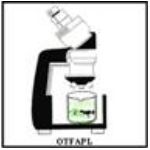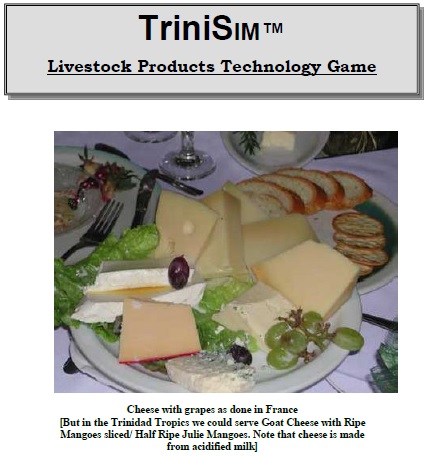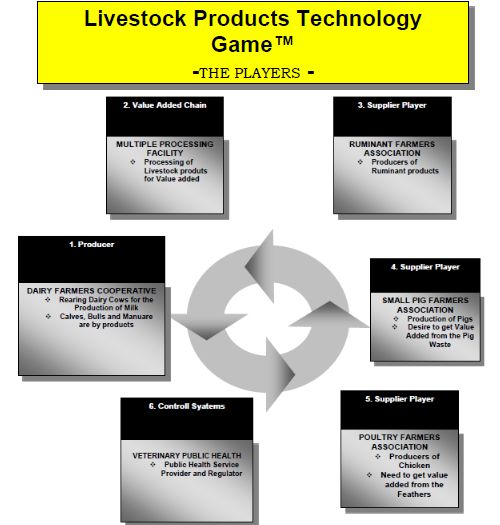
AGLS 2004 - Livestock Products Technology
This Game uses the techniques developed by NEXT [Nick Marsh and Ian Ivey]. The activities involve the use of “Sector Foresighting”/ “Future Vison”/ “FutureSim” techniques.
This approach was developed by Nick Marsh and Ian Ivey of the NEXT Cooperation of New Zealand. The Sector that we shall be looking at is the “Livestock Products Industry/Sector” of Trinidad and Tobago. The Sector would be similar in the other Caricom Countries.
The things that we would like you to address are:
1. The Global Trends in Livestock Products.
2. Issues involved in the Production and Sale of Livestock Products.
3. What are T&T capabilities and enablers for Livestock Products
4. To ask yourself “What can we do to position our company to be successful in this area?”
5. To propose a 1, 3 and 10 year Development Plan and Go-forward Roadmap for your Livestock Product/s Related Company.
The Main Objective of this game is for you to role play and to learn about the principles governing the production, processing and utilization of Products of Livestock/Animal Origin that would be relevant to Trinidad and Tobago and Caricom [not only NOW but also for TOMORROW] while at the same time having a great deal of fun!!!!
This FutureSim™ is played out in the following situation:
• It is set in Trinidad and Tobago
• The time is January 2011
• The Companies would like to develop 1, 3 and10 Year Development Plans [2011 to 2021] based on the Company’s Brief given
Players include:
• Students in Course AGLS2004
• Student Backgrounds
• Environmental Science
• Agriculture and Agri-business Management
• Biology
• Zoology
• Chemsitry
• Wildlife Unit Forestry Division [auditors]
The Components of the Game:
1. The Companies
2. The Company’s Main Mission
3. The Team Development of the Company
4. The Game/Activities that involves you THINKING and OPERATING in the FUTURE
5. The Outcome and Presentation by each company
6. The Presentation
7. The Formal Report
8. The Evaluation of the Student’s Participation
9. The Evaluation of the Learning Outcome by the Students
The Process:
1 Team strategy planning
2 Learning about the Global Livestock Products Situation
3 Learning about the Livestock Products Industry in Trinidad and Tobago and the wider Caribbean
4 Finding out about the knowledge and expertise contained in the other companies
5 Developing your company plans
6 Learning about Livestock Products as it relates to your company
7 Finding out about the other company’s positions and negotiating deals with other companies that are suitable for your company’s future planning
8 Evaluating your position
9 Developing your Company’s 1, 3 and 10 Year Plans
The Outcomes:
Key expected outcomes from this game would include:
• Getting an understanding of how the Theoretical Information and Issues surrounding Livestock Products can be reasonably used and applied within a simulated “Real World Situation”
• Identifying the key “future” tactical and strategic issues and concerns
• Attempting to get you the learner to get insights into the future, involving the possible impacts of changes in technology of possible and probable industry trends
• Acquiring insights into future innovation pathways
• Acquiring insights into future possible consumer markets
• Getting an appreciation of the importance of the consumers of livestock products and the value added chain of livestock products from production to consumption.

(yellowdiv)
Games - Trini Sim Livestock Product Technology
In this section, we cover:
Tini Sim Livestock Product Technology Game - The process, components, players, and outcomes.
Tini Sim Livestock Product Technology Game - The process, components, players, and outcomes.
This Game uses the techniques developed by NEXT [Nick Marsh and Ian Ivey]. The activities involve the use of “Sector Foresighting”/ “Future Vison”/ “FutureSim” techniques.
This approach was developed by Nick Marsh and Ian Ivey of the NEXT Cooperation of New Zealand. The Sector that we shall be looking at is the “Livestock Products Industry/Sector” of Trinidad and Tobago. The Sector would be similar in the other Caricom Countries.
The things that we would like you to address are:
1. The Global Trends in Livestock Products.
2. Issues involved in the Production and Sale of Livestock Products.
3. What are T&T capabilities and enablers for Livestock Products
4. To ask yourself “What can we do to position our company to be successful in this area?”
5. To propose a 1, 3 and 10 year Development Plan and Go-forward Roadmap for your Livestock Product/s Related Company.
The Main Objective of this game is for you to role play and to learn about the principles governing the production, processing and utilization of Products of Livestock/Animal Origin that would be relevant to Trinidad and Tobago and Caricom [not only NOW but also for TOMORROW] while at the same time having a great deal of fun!!!!
This FutureSim™ is played out in the following situation:
• It is set in Trinidad and Tobago
• The time is January 2011
• The Companies would like to develop 1, 3 and10 Year Development Plans [2011 to 2021] based on the Company’s Brief given
Players include:
• Students in Course AGLS2004
• Student Backgrounds
• Environmental Science
• Agriculture and Agri-business Management
• Biology
• Zoology
• Chemsitry
• Wildlife Unit Forestry Division [auditors]
The Components of the Game:
1. The Companies
2. The Company’s Main Mission
3. The Team Development of the Company
4. The Game/Activities that involves you THINKING and OPERATING in the FUTURE
5. The Outcome and Presentation by each company
6. The Presentation
7. The Formal Report
8. The Evaluation of the Student’s Participation
9. The Evaluation of the Learning Outcome by the Students
The Process:
1 Team strategy planning
2 Learning about the Global Livestock Products Situation
3 Learning about the Livestock Products Industry in Trinidad and Tobago and the wider Caribbean
4 Finding out about the knowledge and expertise contained in the other companies
5 Developing your company plans
6 Learning about Livestock Products as it relates to your company
7 Finding out about the other company’s positions and negotiating deals with other companies that are suitable for your company’s future planning
8 Evaluating your position
9 Developing your Company’s 1, 3 and 10 Year Plans
The Outcomes:
Key expected outcomes from this game would include:
• Getting an understanding of how the Theoretical Information and Issues surrounding Livestock Products can be reasonably used and applied within a simulated “Real World Situation”
• Identifying the key “future” tactical and strategic issues and concerns
• Attempting to get you the learner to get insights into the future, involving the possible impacts of changes in technology of possible and probable industry trends
• Acquiring insights into future innovation pathways
• Acquiring insights into future possible consumer markets
• Getting an appreciation of the importance of the consumers of livestock products and the value added chain of livestock products from production to consumption.
Figure: Key Players

back to top

